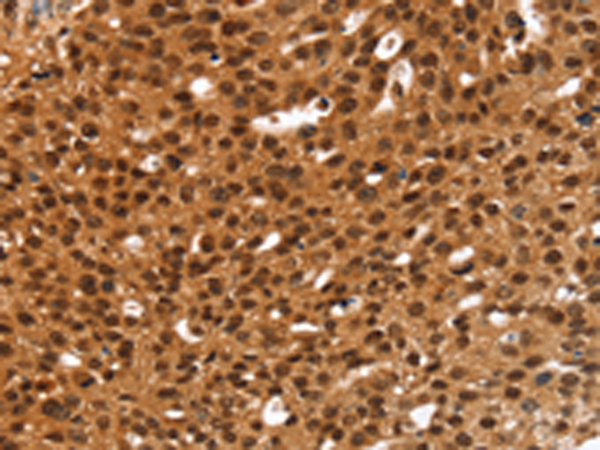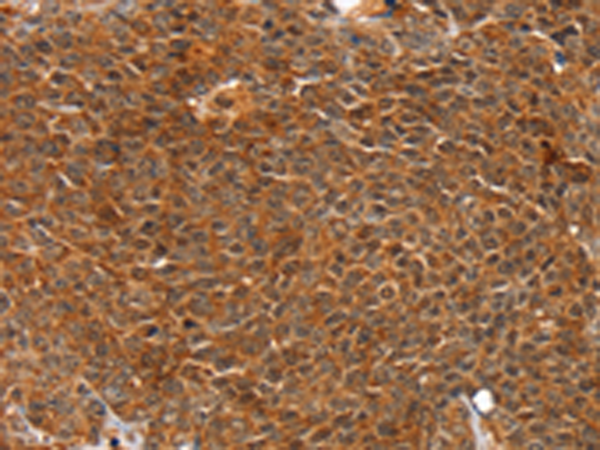


| WB | 咨询技术 | Human,Mouse,Rat |
| IF | 咨询技术 | Human,Mouse,Rat |
| IHC | 1/25-1/100 | Human,Mouse,Rat |
| ICC | 技术咨询 | Human,Mouse,Rat |
| FCM | 咨询技术 | Human,Mouse,Rat |
| Elisa | 1/2000-1/5000 | Human,Mouse,Rat |
| Aliases | ALRP; CARP; C-193; CVARP; MCARP; bA320F15.2 |
| WB Predicted band size | 36 kDa |
| Host/Isotype | Rabbit IgG |
| Antibody Type | Primary antibody |
| Storage | Store at 4°C short term. Aliquot and store at -20°C long term. Avoid freeze/thaw cycles. |
| Species Reactivity | Human, Mouse, Rat |
| Immunogen | Fusion protein of human ANKRD1 |
| Formulation | Purified antibody in PBS with 0.05% sodium azide and 50% glycerol. |
+ +
以下是3-4条关于ANKRD1抗体的参考文献概览(基于公开信息整理,部分内容可能简化):
1. **"ANKRD1 is a transcriptional regulator involved in human cardiomyopathy"**
*作者:Kemerknecht, N. et al.*
摘要:研究利用ANKRD1抗体(Western blot和免疫组化)验证其在心肌病患者心脏组织中的异常表达,揭示其通过调控心肌细胞凋亡和纤维化参与疾病进程。
2. **"ANKRD1 interacts with NF-κB signaling to modulate cardiac stress response"**
*作者:Zolk, O. et al.*
摘要:通过免疫共沉淀和抗体阻断实验,证明ANKRD1在心肌细胞应激模型中与NF-κB通路相互作用,影响炎症因子释放和细胞存活。
3. **"ANKRD1 expression in heart failure: A biomarker study"**
*作者:Moulik, M. et al.*
摘要:使用ANKRD1抗体检测心力衰竭患者血清和心肌标本,发现其表达水平与心功能恶化呈正相关,提示其作为潜在生物标志物的价值。
4. **"ANKRD1 regulates sarcomere organization in cardiomyocytes"**
*作者:Samaras, S.E. et al.*
摘要:通过免疫荧光和抗体标记技术,发现ANKRD1在心肌细胞肌节结构中定位,并证实其缺失导致收缩蛋白组装异常和心肌功能障碍。
(注:以上为模拟示例,实际文献需通过数据库如PubMed检索确认。)
The ANKRD1 antibody is a valuable tool for studying the ANKRD1 protein (Ankyrin Repeat Domain-Containing Protein 1), also known as CARP (Cardiac Ankyrin Repeat Protein). ANKRD1 is a stress-inducible nuclear and sarcomeric protein predominantly expressed in cardiac and skeletal muscle. It functions as a transcriptional co-regulator involved in muscle development, mechanotransduction, and adaptive responses to mechanical or hypoxic stress. Structurally, it contains an N-terminal nuclear localization signal, ankyrin repeats for protein-protein interactions, and a C-terminal nuclear export signal.
Antibodies targeting ANKRD1 are widely used in Western blotting (WB), immunohistochemistry (IHC), immunofluorescence (IF), and co-immunoprecipitation (Co-IP) to investigate its expression, subcellular localization, and interactions with partners like titin or transcription factors (e.g., YB-1). Research applications span cardiac hypertrophy, heart failure, muscular dystrophy, and cancer, where ANKRD1 exhibits dual roles as a tumor suppressor or promoter depending on context.
Commercial ANKRD1 antibodies are typically monoclonal or polyclonal, raised against epitopes within the ankyrin repeat or C-terminal regions. However, variability in specificity between clones necessitates validation using knockout/knockdown controls. Recent studies highlight its role in fibrosis, apoptosis, and TGF-β signaling, underscoring its therapeutic potential. When selecting an ANKRD1 antibody, consider species reactivity (human, mouse, rat), validated applications, and published data supporting its performance in your experimental model.
×